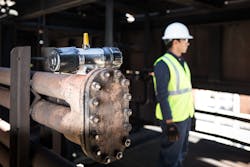Wireless gas detection ‘comes of age’ with better data systems, battery technology
Effective gas detection and monitoring has long been a key priority for businesses operating in the UK’s offshore oil and gas sector. But the industry has been slow to deploy wireless detection and monitoring technologies. There is a reason for this. While wireless technology has become ubiquitous in most people’s lives, it is only relatively recently (the last six or so years) that it has become a viable option for gas detection and monitoring for the offshore oil and gas industry. Wireless technology for offshore environments has now “come of age.”
The reasons for this “coming of age” can be split into two key areas.
First, industrial wireless technology has seen significant advances in recent years. While the early adoption of wireless gas detection developed a poor reputation for patchy coverage and unreliable connections, data communications are now guaranteed. This is a crucial component for effective wireless monitoring systems, and it allows for detection of gas to be communicated reliably and in real-time using an ISA 100 industrial wireless system. This system is guaranteed to be secure and is specifically designed to carry small data packages, of around the size of 10 text characters, within a specified timeframe and with complete reliability.
Second, there has been considerable progress when it comes to innovation in relation to device power consumption. Battery life has historically been a significant issue for wireless gas detection, but some of the more recent advances in technology have resulted in step-change reductions (in some cases by orders of magnitude) in power consumption. This has also been critical in offsetting more power-hungry functions which have otherwise advanced device functionality.
The result is that battery life has improved considerably, with certain devices on the market guaranteeing up to two full years of battery life, compared to only a few months in the early days.
The cumulative impact of these innovations has been significant, and importantly, comes at a time when many legacy (wired) gas detection installations are now desperately in need of updating.
Two or three decades after the UK’s first wired gas detection devices were introduced, both the technology and key drivers for monitoring have evolved. Environmental issues related to methane detection could soon rank alongside ongoing safety concerns around explosion risk, and standards around coverage and numbers of devices have also changed. Often, it is the inflexibility of hard-wired networks to respond to these sorts of changes, plus the vast costs involved in replacing cabling, that is now prompting operators to explore wireless alternatives. To prove the flexibility of wireless gas detection, it is now possible to rent a compliant fixed gas detection system for short-medium term coverage.
The ability to do away with the miles of cabling, which often has a life span of just 10-15 years, is a major advantage of wireless technology.
Installation and commissioning costs for wireless systems are typically a quarter that of a cabled system, and Equinor recently published figures outlining the cost savings that can be realized through wireless installations. Their findings suggest that wireless detectors can bring savings of 60% for an offshore installation and 80% for an onshore installation.
One of the final – and perhaps most substantial – advantages of wireless technology is the fact that no site downtime is required. Wireless devices are intrinsically safe, so they can be installed on live sites; and this offers a huge additional cost saving.
Recently, the largest wireless gas detection network ever deployed in the North Sea was completed. It includes 120 wireless devices across a remote 7-sq mi (18-sq km) site, and there is little doubt that this sort of project will become more commonplace as greater awareness develops and the full potential of the technology is realized.

